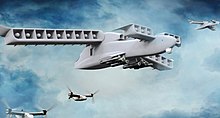
The Vertical Take-Off and Landing Experimental Aircraft (VTOL X-Plane) program was an American research project sponsored by the Defense Advanced Research Projects Agency (DARPA). The goal of the program was to demonstrate a VTOL aircraft design that can take off vertically and efficiently hover, while flying faster than conventional rotorcraft.[1] There have been many previous attempts, most of them unsuccessful as of 2015.[2][3]
A helicopter with a conventional rotor layout has a theoretical top speed of 200 knots (230 mph; 370 km/h), after which it suffers from dissymmetry of lift. Some designs have successfully created hovering and high-speed aircraft, including the Bell Boeing V-22 Osprey tiltrotor that can fly at 275 knots (316 mph; 509 km/h) and the Sikorsky X2 compound helicopter that flew at 260 knots (300 mph; 480 km/h), but both made significant aerodynamic compromises to hovering efficiency or range. DARPA's goal was to demonstrate a VTOL aircraft that can achieve a sustained top speed of 300 to 400 knots (345 to 460 mph (555 to 740 km/h)).[1]
All competitors for the program opted to demonstrate their concepts using an unmanned aerial vehicle even though it was not required, but the technologies were intended to be applied to manned aircraft as well.[4]
Aurora Flight Sciences was selected to create a test design, which would fly in 2018.[5] DARPA canceled the program in 2018 before the flight testing, citing growing commercial interest and the lack of a military partner.[6]
In September 2022, DARPA initiated the ANCILLARY program to develop a small VTOL uncrewed aerial system (UAS) with low weight, high payload, and long endurance capabilities, X-plane flight tests scheduled for 2026.[7][8][9]
- ^ a b DARPA Awards Contracts in Search of a 460 MPH Helicopter - News.USNI.org, 19 March 2014
- ^ Cite error: The named reference
gwwas invoked but never defined (see the help page). - ^ Whittle, Richard. "The Next X-Plane" Air & Space/Smithsonian, October 2015. Accessed: 26 September 2015.
- ^ DARPA’s Selects Four Developers for new X-Plane Program - Defense-Update.com, 18 March 2014
- ^ VIDEO: Aurora’s LightningStrike wins DARPA VTOL X-plane comp - Flightglobal.com, 4 March 2016
- ^ Cite error: The named reference
:0was invoked but never defined (see the help page). - ^ Tingley, Brett (September 9, 2022). "DARPA developing small vertical-takeoff aircraft for military use". space.com. Retrieved June 7, 2024.
- ^ "DARPA's Ancillary X-Plane Program Aims To Raise The Bar For VTOL UAS | Aviation Week Network". aviationweek.com. Retrieved June 7, 2024.
- ^ "ANCILLARY Project Selects Teams to Develop Initial Concepts for VTOL X-Plane". darpa.mil. June 22, 2023. Retrieved June 7, 2024.